Are you thinking about selling or buying a 1992 penny and wondering how much it’s really worth?
The 1992 Lincoln Memorial penny continues the legacy of a coin series that began in 1909, honoring President Abraham Lincoln, one of America’s most revered leaders. While these pennies are not especially rare, they’re still very collectible, especially for beginners—and certain varieties with mint errors can be worth hundreds or even thousands of dollars.
This guide will walk you through the value of the 1992 penny, its background, and which varieties you should be keeping an eye out for.
1992 Penny Value Chart (All Varieties)
| Mint Mark | Condition | Value |
|---|---|---|
| 1992 (No Mint Mark) | Uncirculated | $0.36 |
| 1992-D | Uncirculated | $0.36 |
| 1992-S (Proof) | Proof (PR/PF 65+) | $6.12 |
Note: These values reflect standard examples. Pennies with rare varieties or mint errors (like the 1992 Close AM) can be worth significantly more.
The History of the 1992 Penny

The Lincoln penny holds a special place in American numismatic history. First struck in 1909, it’s one of the longest-running coin series in U.S. circulation. Initially designed by Victor David Brenner, this penny was the first widely circulated U.S. coin to feature a real person—President Abraham Lincoln.
Design Evolution
While the obverse (front) of the penny featuring Lincoln’s portrait has remained mostly unchanged, the reverse (back) has undergone several redesigns:
- 1909–1958: Wheat ears (Wheat Pennies)
- 1959–2008: Lincoln Memorial (by Frank Gasparro)
- 2009: Four Bicentennial designs celebrating Lincoln’s life
- 2010–Present: Union Shield
The 1992 penny belongs to the Lincoln Memorial design era (1959–2008), which honored the 150th anniversary of Lincoln’s birth. The reverse features the Lincoln Memorial, designed by Frank Gasparro, and if you look closely, you can even see a tiny depiction of Lincoln’s statue inside the monument—mirroring the real-life Memorial in Washington, D.C.
Metal Composition
Originally, Lincoln cents were composed of 95% copper, with a blend of zinc and tin. However, due to rising copper prices and limited supply, the U.S. Mint altered the composition:
- Pre-1982: 95% copper, 5% zinc/tin
- Post-1982 (including 1992): Copper-plated zinc — 97.5% zinc with a 2.5% copper outer layer
The 1992 penny, therefore, is a copper-clad zinc coin, weighing 2.5
Features of the 1992 Penny
The Obverse of the 1992 Penny
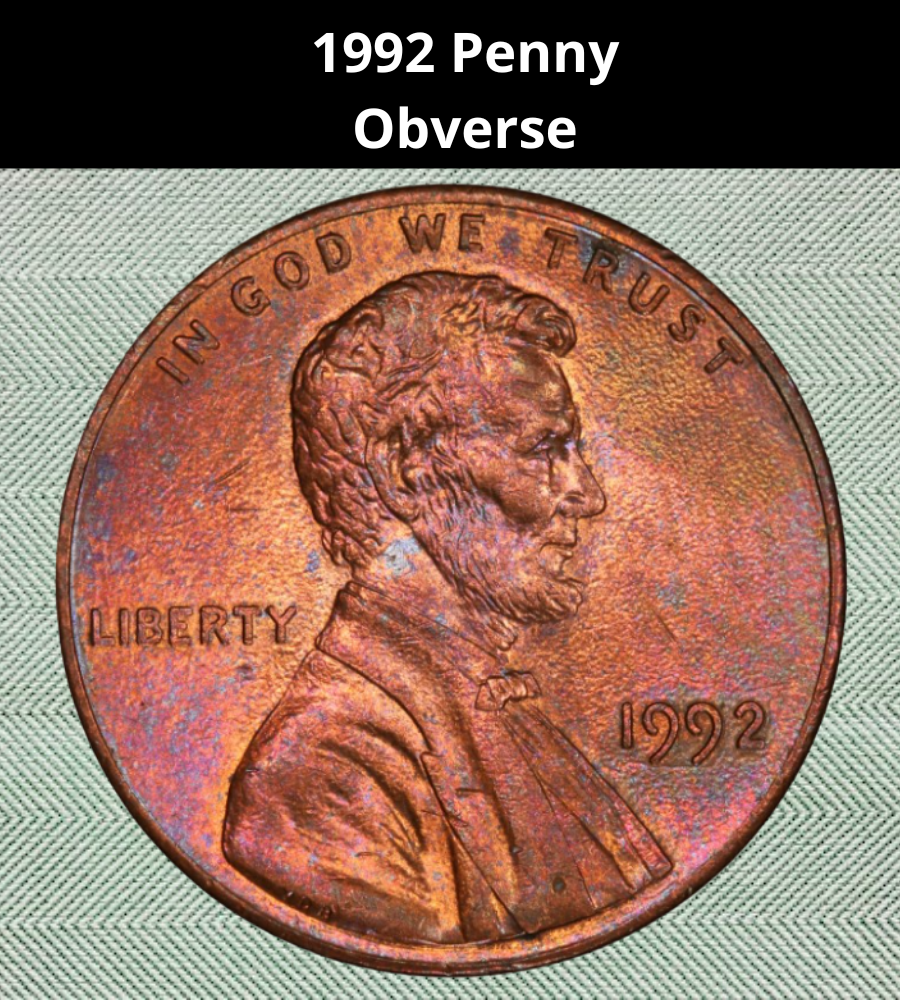
The obverse of the 1992 Lincoln penny features a detailed, right-facing portrait of President Abraham Lincoln, honoring his enduring legacy in American history.
This iconic design, originally created by Victor David Brenner, has remained largely unchanged since the coin’s debut in 1909. It was the first circulating U.S. coin to depict a real person, symbolizing a shift in American coinage tradition.
Key Design Elements
- IN GOD WE TRUST – The national motto arcs along the top rim of the coin.
- LIBERTY – Appears to the left of Lincoln’s portrait, positioned behind his back.
- Date (1992) – Struck on the right side, in front of Lincoln’s profile.
Depending on the mint of origin, the coin may include a mint mark just below the date:
- No mint mark: Philadelphia
- “D”: Denver
- “S”: San Francisco (for proof coins only)
This clean and dignified design reflects Lincoln’s solemn character and has remained a mainstay on U.S. coinage for over a century.
The Reverse of the 1992 Penny
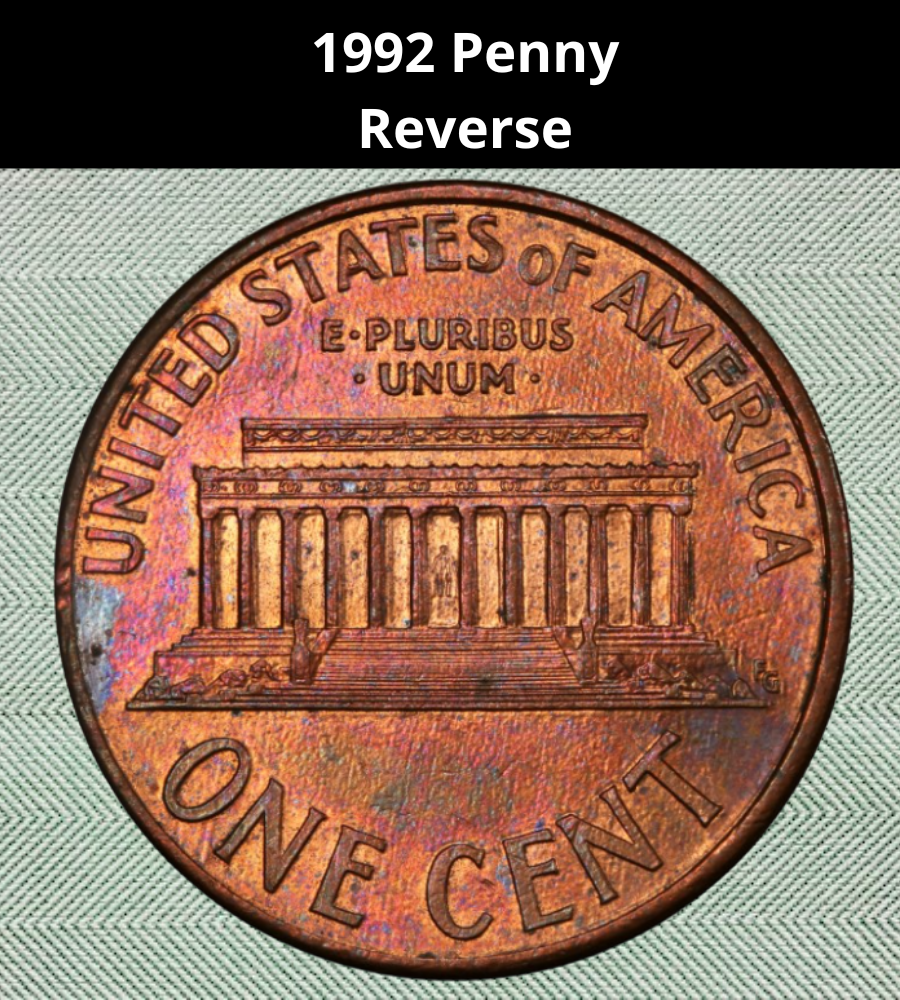
The reverse of the 1992 Lincoln penny features a detailed depiction of the Lincoln Memorial, a symbol of national unity and reverence for President Abraham Lincoln.
Originally designed by Frank Gasparro, this reverse was introduced in 1959 to commemorate Lincoln’s 150th birth anniversary. Despite never having seen the Memorial in person, Gasparro captured its grandeur with impressive detail.
Key Design Elements
- Lincoln Memorial – The central feature, shown in a frontal view. Within the structure, you can discern a tiny seated statue of Lincoln, a subtle yet remarkable artistic touch.
- UNITED STATES OF AMERICA – Arched boldly along the top rim.
- E PLURIBUS UNUM – Latin for “Out of many, one,” appears directly below the country’s name.
- ONE CENT – The coin’s denomination is displayed prominently along the bottom rim.
- FG Initials – The designer’s initials, FG (for Frank Gasparro), are located discreetly on the far right of the Memorial’s base, near the steps.
This reverse design was used from 1959 to 2008 and is recognized for blending architectural precision with patriotic symbolism.
Other Features of the 1992 Penny
The 1992 Lincoln penny is a compact yet iconic piece of U.S. coinage with the following physical characteristics:
- Diameter: 19.00 millimeters
- Weight: 2.50 grams
- Metal Composition: Copper-plated zinc
- 97.5% zinc core
- 2.5% copper outer layer
- Edge: Plain (smooth, with no reeding)
This copper-clad design replaced the earlier bronze composition in the early 1980s due to rising copper costs. The shift made 1992 pennies more economical to produce, though less valuable in intrinsic metal content.
Mint Marks
- Denver Mint coins are marked with a “D”, which appears just below the year “1992” on the obverse.
- Philadelphia and San Francisco Mint coins do not carry a mint mark.
1992 Penny Grading Guide
Grading Lincoln Memorial pennies—like the 1992 cent—involves evaluating two key factors: condition and color.
Color Classifications
Lincoln pennies are categorized by toning into:
- Red (RD): Bright, coppery, and uncirculated appearance. These are the most desirable and valuable.
- Red-Brown (RB): Moderate circulation; some original luster remains.
- Brown (BN): Heavily circulated; the original copper luster has faded significantly.
💡 Tip: Red coins are typically uncirculated or lightly circulated, making them the best candidates for investment or collection.
What to Look for in a High-Grade 1992 Penny
- Uncirculated Condition: Retains original mint luster with no signs of wear.
- High-Point Detail: Sharp detail on Lincoln’s hair, beard, and shoulders.
- Reverse Detail: Well-struck Lincoln Memorial steps and crisp lettering on “ONE CENT”.
Coins that meet these standards may qualify for higher mint state grades, which greatly increases their value.
Grading Scale Overview
| Grade Level | Description |
|---|---|
| 1 | Basal State |
| 2 | Fair |
| 3 | Very Fair |
| 4–6 | Good |
| 7–10 | Very Good |
| 12–15 | Fine |
| 20–30 | Very Fine |
| 40 | Extremely Fine |
| 50 | About Uncirculated |
| 60 | Mint State (MS60) |
| 65 | Gem Mint State (MS65) |
| 70 | Perfect Mint State (MS70) |
Note: For the most accurate valuation, use a reputable coin grading guide or consult a professional coin grading service.
Next, we’ll explore how much your 1992 penny is worth based on these grades and other factors like rarity and mint mark.
1992 Penny Value Guides
1992 No-Mint Mark Penny Value
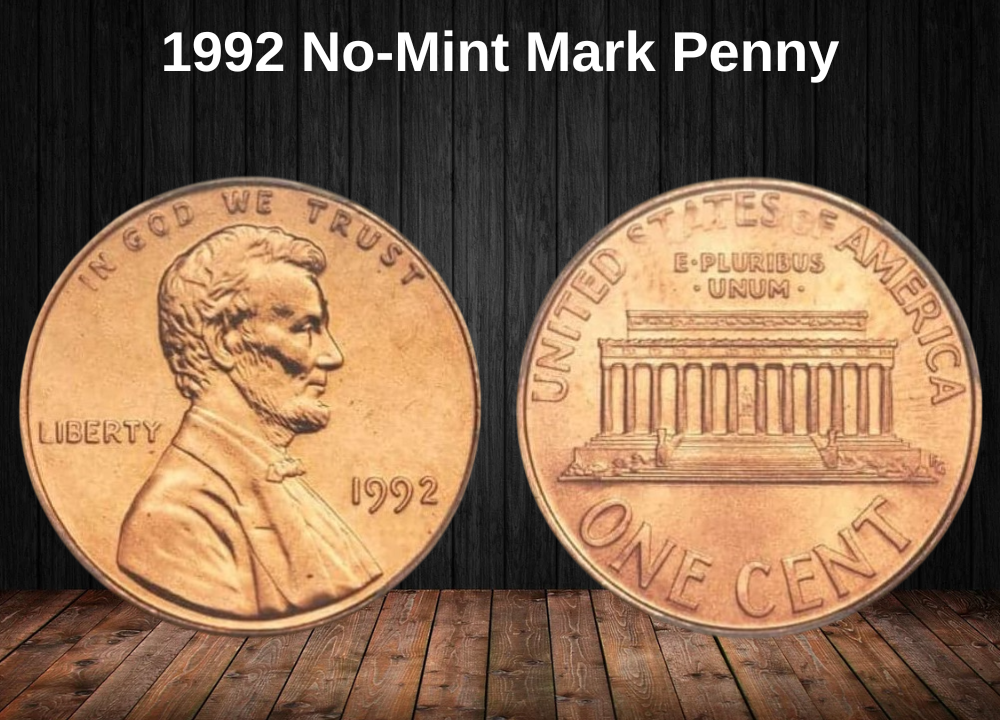
The Philadelphia Mint struck an impressive 4,648,905,000 Lincoln pennies in 1992, the highest among all mints that year.
Thanks to improved minting technology, most of these coins were well-struck, but the sheer volume makes them very common and generally inexpensive, even for beginner collectors.
Value by Condition and Color
| Condition | Color | Estimated Value |
|---|---|---|
| Circulated | Brown | $0.05 – $0.10 |
| Mint State (MS65) | Red | ~$10 |
| Mint State (MS67) | Red | ~$26 |
Red specimens are the most desirable due to their original mint luster and uncirculated condition. Even in MS67, these coins are affordable and accessible to most collectors.
1992-D Penny Value
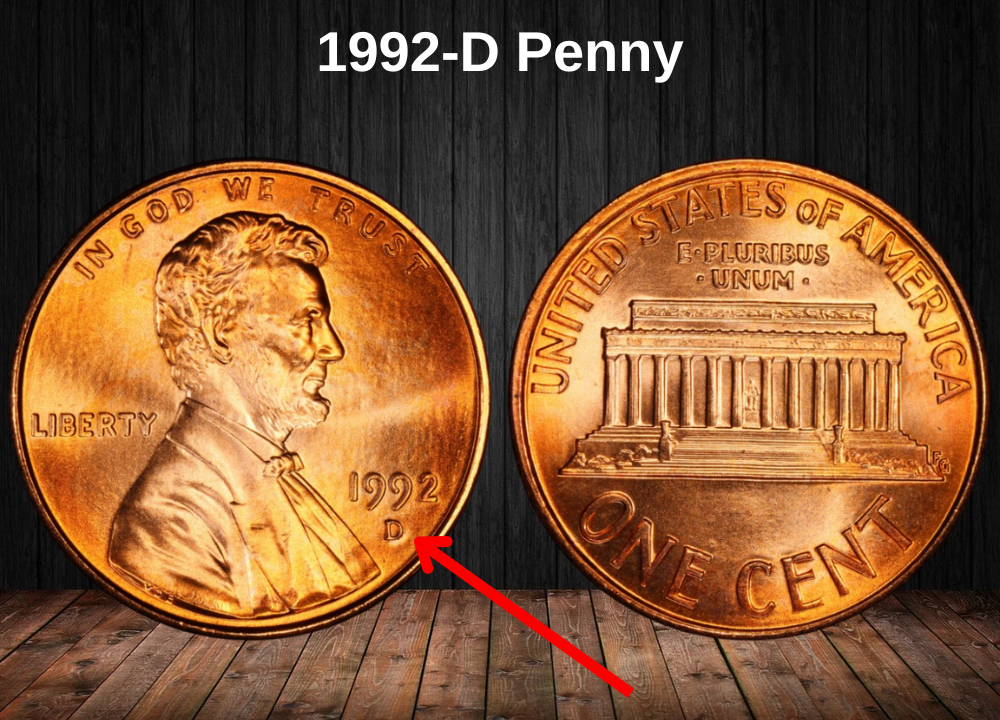
The Denver Mint produced an estimated 4,448,673,300 Lincoln cents in 1992—just slightly fewer than Philadelphia’s output. With such a massive mintage, the 1992-D penny is common and widely available, making it affordable at nearly all grade levels.
Value by Condition and Color
| Condition | Color | Estimated Value |
|---|---|---|
| Circulated | Brown | ~$0.05 |
| Mint State (MS65) | Red | ~$10 |
| Mint State (MS67) | Red | ~$30 |
Red Mint State coins are more desirable due to their bright, uncirculated appearance and sharper strikes.
Notable Sale
A rare 1992-D penny graded MS69 fetched a staggering $5,175 at a Stack’s Bowers auction in 2012—an exceptional price for a modern Lincoln cent.
1992-S Proof Penny Value
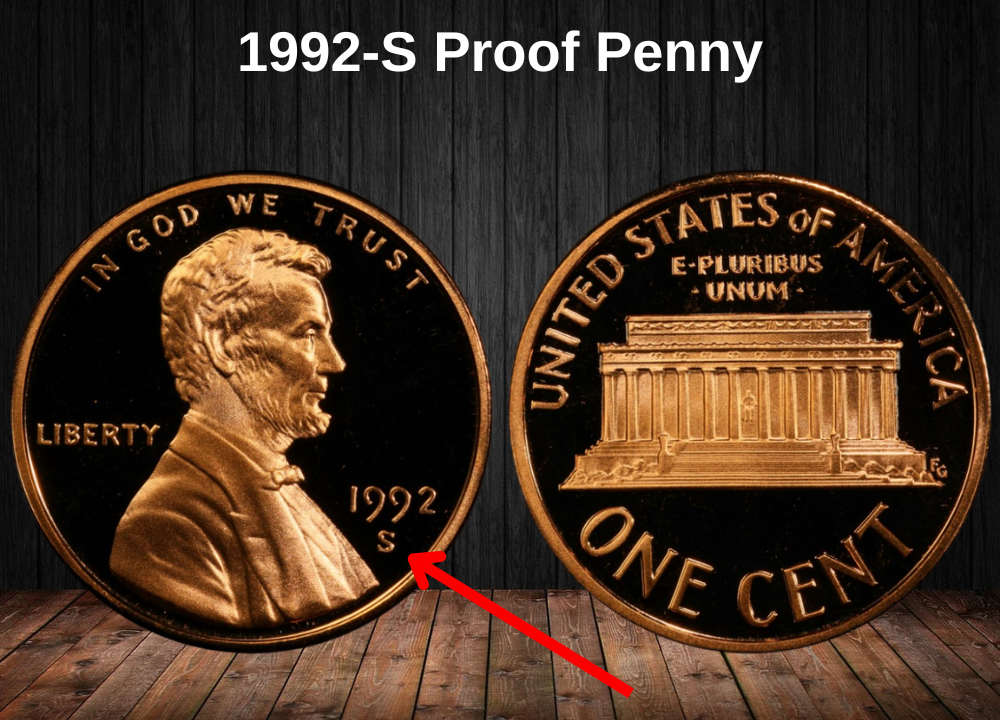
The San Francisco Mint exclusively produced proof Lincoln Memorial pennies in 1992, with a total mintage of approximately 4,176,000 coins.
These proof coins are specially struck for collectors, featuring:
- Frosted details
- Mirror-like surfaces
- Sharp strikes with brilliant luster
Value by Grade
| Grade | Estimated Value |
|---|---|
| PF65 | ~$4 |
| PF67 Red | ~$6 |
| PF69 Deep Cameo | ~$30–$95 |
| PF70 | Up to $1,380 |
PF70 examples are rare and command premium prices at auction. One such coin sold for $1,380 at Heritage Auctions in 2003.
Collectibility
Despite the high mintage for a proof coin, 1992-S proof pennies are common, making them an accessible entry point for collectors looking to own a beautifully struck Lincoln cent from the early ’90s.
Rare 1992 Penny Errors List
1992 Wide and Close AM Penny Errors
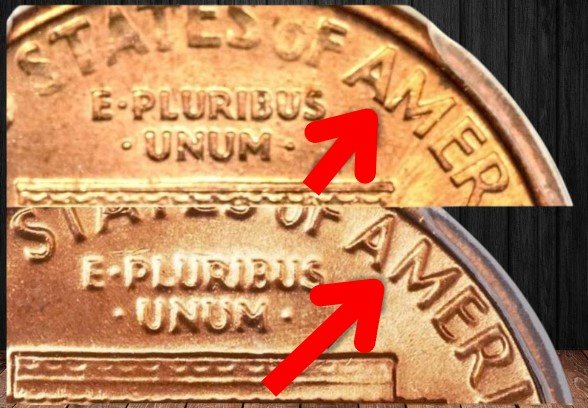
One of the most notable modern errors in Lincoln Memorial cents is the “Close AM” vs. “Wide AM” variety, and 1992 is among the most famous years for this error.What Is the Close AM Error?
This error concerns the spacing of the letters “A” and “M” in “AMERICA” on the coin’s reverse:
- Close AM: The A and M are so close they’re nearly touching.
- Wide AM: There is a noticeable gap between the A and M.
Additionally:
- On Close AM varieties, Frank Gasparro’s initials (FG) are set farther from the Lincoln Memorial.
- On Wide AM varieties, the FG initials are closer to the building.
Where to Find It?
The Close AM error is found on both:
- 1992 No-Mint Mark (Philadelphia) Pennies
- 1992-D (Denver Mint) Pennies
However, the 1992 Close AM pennies are exceptionally rare, and therefore much more valuable than their Wide AM counterparts.
1992 Close AM Penny Value
| Coin | Grade | Price Realized | Auction House / Year |
|---|---|---|---|
| 1992 Close AM (No Mint) | NGC Genuine | $5,000 | Online Auction, 2022 |
| 1992-D Close AM | AU58 | $3,525 | Stack’s Bowers, 2012 |
Why It Matters
The 1992 Close AM error was never intended for circulation. It occurred when a proof reverse die (used only for special proof coins) was mistakenly used on regular business strikes.
As a result, these error coins are exceptionally scarce, and even circulated examples can fetch thousands of dollars.
Tip for Collectors: Check your 1992 and 1992-D pennies carefully—finding a Close AM variety could be like striking gold!
1992 Doubled-Die Crack Penny Error
One of the more intriguing error varieties in the 1992 Lincoln penny series is the doubled-die crack error.
What Is a Doubled-Die Crack Error?
This error happens when the die used to strike coins becomes cracked from prolonged use. As mint workers continue to use this damaged die, the resulting coins show raised lines, cracks, or dents—the impressions of the cracked die transferred onto the coin’s surface.
Unlike standard doubled-die errors (where design elements appear doubled due to misaligned strikes), this error is caused by structural failure in the die itself.
What to Look For:
- Visible cracks or raised lines, often appearing across Lincoln’s head, the fields, or the Lincoln Memorial.
- Multiple or branching cracks might indicate a heavily damaged die.
- Moderate cracks are typically more collectible—too minor may go unnoticed, while extreme cracks can reduce visual appeal.
Value of a 1992 Doubled-Die Crack Penny
The value depends on the extent and placement of the crack and the coin’s condition:
| Condition | Estimated Value |
|---|---|
| Circulated w/ visible crack | $35 – $50 |
| Uncirculated (Mint State) | $60 – $90+ |
Collector’s Tip:
These coins are fascinating because each crack is slightly unique, making them attractive to error collectors. Always inspect your 1992 pennies under magnification for fine die cracks—what looks like a small flaw could actually be a sought-after mint error.
Would you like help identifying or valuing a specific 1992 error penny you own? You can upload an image, and I’ll help you examine it.
1992 Doubled Die Obverse/Reverse Penny Error
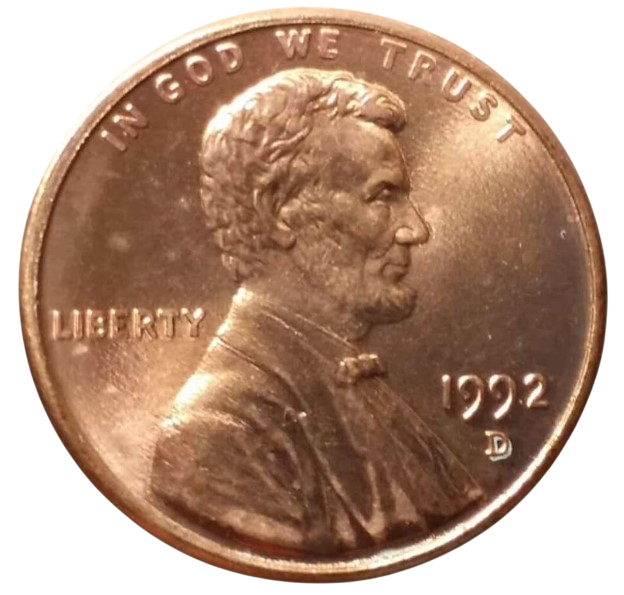
Doubled die errors are among the most recognized and sought-after mint mistakes in U.S. coinage, and the 1992 Lincoln Memorial penny series includes some notable examples.
What Is a Doubled Die Error?
A doubled die error occurs during the die creation process, not during the striking of the coin itself. It happens when the hub strikes the die more than once at slightly different angles, misaligning the design features. Coins struck by this flawed die will display visible doubling on one or more design elements.
1992 Penny Doubled Die Features
In the 1992 Lincoln cents, both the obverse and reverse may show doubling. Key areas to inspect include:
Obverse (Front):
- IN GOD WE TRUST
- LIBERTY
- The date “1992”
- Mint mark “D” (for Denver issues)
Reverse (Back):
- E PLURIBUS UNUM
The doubling can range from minor to dramatic, so using magnification is recommended for proper identification.
Value of a 1992 Doubled Die Penny
The value depends on the clarity of the doubling and the coin’s grade:
| Condition | Estimated Value |
|---|---|
| Circulated | $50 – $75 |
| Mint State (MS60–MS64) | $90 – $120 |
| High Grade (MS65+) | $130 – $150+ |
Collector’s Tip:
Always verify doubling under good lighting using a loupe or microscope. True doubled dies are distinct from machine doubling, which tends to appear flatter and less crisp. Certification by a reputable grading service (like PCGS or NGC) can help confirm authenticity and maximize resale value.
1992 Struck Through Penny Error

This error happens when a foreign object (like grease, dust, or metal shavings) gets caught between the die and the planchet during striking, leaving a noticeable mark on the obverse or reverse.
How to identify: Look for a sunken area, missing details, or unusual surface texture.
Estimated value:
- Minor errors: $20 – $40
- Moderate errors: $50 – $75
- Major errors in uncirculated condition: Up to $100 or more
Where to sell your penny?
Now that you know the value of your penny, you might be wondering where to sell it. Don’t worry: here’s a guide to some of the best online platforms where you can easily sell your coins, along with their advantages and disadvantages.
Discover the best platforms for selling coins online (pros and cons).
FAQ about the 1992 penny
1. What makes the 1992 Close AM variety so rare and valuable?
The 1992 Close AM penny refers to a reverse design error where the A and M in “AMERICA” are nearly touching, instead of having the normal wide spacing. This reverse design was intended for the 1993 penny, but a few 1992 dies were mistakenly struck with it.
- 1992 Philadelphia Close AM: Fewer than 20 known. Value ranges from $5,000 to over $25,000 depending on grade.
- 1992-D Close AM: Even rarer; possibly one of a kind. One sold for over $20,000.
2. How can I identify a 1992 Close AM penny from a regular Wide AM coin?
Look at the reverse side of the coin:
- In the Close AM, the bottoms of the “A” and “M” in AMERICA almost touch.
- In the Wide AM, there’s a visible gap between the letters.
Also, check the FG initials under the right side of the Lincoln Memorial. On a Close AM, they are slightly farther from the building.
3. Why were the 1992 Close AM coins struck, and how did the error happen?
This is a transitional design error. The Close AM reverse was scheduled for 1993, but some dies were prepared and used prematurely in 1992.
This mistake likely occurred at the die preparation stage, where reverse dies intended for proofs or future circulation use were mismatched with 1992 obverse dies.
4. What are the composition and physical characteristics of the 1992 penny?
- Core: 97.5% zinc
- Coating: 2.5% copper plating
- Weight: 2.5 grams
This zinc-based composition is more prone to corrosion and plating issues, especially if damaged or stored in poor environments.
5. Do 1992 proof pennies have the Close AM variety as well?
No known 1992-S proof pennies have been found with the Close AM reverse. All known Close AM examples are business strike coins from Philadelphia and Denver.
6. Besides Close AM, are there other valuable 1992 penny errors or varieties?
Yes. Collectors look for:
- Doubled die obverses (look at “LIBERTY” and “IN GOD WE TRUST”)
- Die cracks or cuds
- Off-center strikes
- Clipped planchets
But none rival the value or fame of the Close AM errors.
7. What are the values of regular 1992 pennies in high grades?
Most 1992 pennies in circulation are worth face value. However:
- MS-65 Red (RD) examples can be worth $5 to $10
- MS-67 RD or higher graded coins may fetch $100+
- Only coins with flawless surfaces, strong luster, and no carbon spots earn premium prices


















































